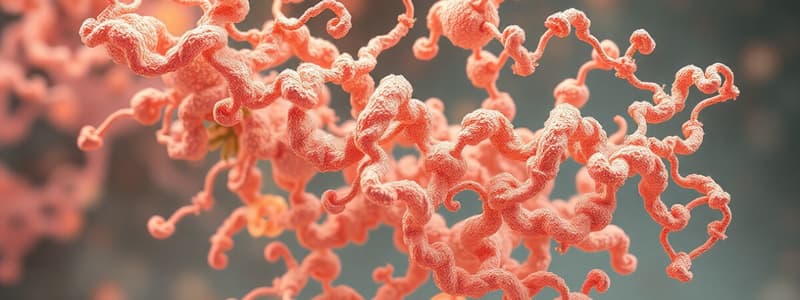Podcast
Questions and Answers
What type of reaction joins amino acids together to form polypeptides?
What type of reaction joins amino acids together to form polypeptides?
- Hydrolysis
- Condensation reaction
- Dehydration synthesis (correct)
- Oxidation reaction
What is the primary structure of a protein?
What is the primary structure of a protein?
- The hydrogen bonding pattern
- A linear chain of amino acids (correct)
- The overall 3D shape of the protein
- The interaction of multiple polypeptides
Which of the following is NOT a characteristic of tertiary structure in proteins?
Which of the following is NOT a characteristic of tertiary structure in proteins?
- Determined by R group interactions
- Results in a unique 3D shape
- Involves nonpolar amino acids being hydrophobic
- Includes hydrogen bonding between backbones (correct)
How does the directionality of a polypeptide chain affect its construction?
How does the directionality of a polypeptide chain affect its construction?
What type of R group interactions contribute to the tertiary structure of proteins?
What type of R group interactions contribute to the tertiary structure of proteins?
Which statement accurately describes the role of R groups in amino acids?
Which statement accurately describes the role of R groups in amino acids?
What is quaternary structure in proteins?
What is quaternary structure in proteins?
How do hydrophilic and hydrophobic amino acids interact in a protein?
How do hydrophilic and hydrophobic amino acids interact in a protein?
What determines the biological function of a protein?
What determines the biological function of a protein?
Why are proteins considered the most diverse organic molecules?
Why are proteins considered the most diverse organic molecules?
Flashcards
Proteins
Proteins
Organic macromolecules built from a chain of amino acids linked by covalent bonds.
Amino acids
Amino acids
Monomers that make up proteins, each with a central carbon atom bonded to a hydrogen atom, a carboxyl group, an amino group, and a variable 'R group'.
R Group
R Group
The part of an amino acid that determines its unique chemical properties. It varies between different amino acids.
Dehydration Synthesis
Dehydration Synthesis
Signup and view all the flashcards
Polypeptide
Polypeptide
Signup and view all the flashcards
N-terminus
N-terminus
Signup and view all the flashcards
C-terminus
C-terminus
Signup and view all the flashcards
Primary Structure
Primary Structure
Signup and view all the flashcards
Secondary Structure
Secondary Structure
Signup and view all the flashcards
Tertiary Structure
Tertiary Structure
Signup and view all the flashcards
Study Notes
Protein Structure and Function
- Proteins are organic macromolecules composed of amino acids.
- Twenty different amino acids exist, each with a unique "R group" which determines its properties.
- Amino acids contain carbon, hydrogen, oxygen, and nitrogen.
- Amino acids share a similar backbone structure featuring a central carbon atom, hydrogen, carboxyl and amino groups.
Amino Acid Bonding and Polypeptides
- Amino acids bond together via dehydration synthesis.
- This reaction links the carboxyl group of one amino acid to the amino group of another, forming a covalent peptide bond.
- The resulting linear chain of amino acids is called a polypeptide.
- Polypeptides have directionality, with a free amino (N-terminus) end and a free carboxyl (C-terminus) end.
- The specific sequence of amino acids in a polypeptide defines the protein's primary structure.
Protein Secondary, Tertiary, and Quaternary Structures
-
Secondary structure involves the polypeptide chain folding into patterns like alpha helices and beta sheets, stabilized by hydrogen bonds between the backbone.
-
Tertiary structure describes the overall 3D shape of the polypeptide, determined by interactions between R groups.
-
R group interactions (hydrophobic, hydrophilic, ionic) shape the protein's 3D structure.
-
Hydrophobic R groups tend to cluster inside the protein, while hydrophilic and ionic groups interact with the surrounding water.
-
Quaternary structure occurs when multiple polypeptide chains associate to form a functional protein.
-
An example of a protein with quaternary structure is haemoglobin.
Protein Shape and Function
- A protein's unique 3D shape (tertiary structure) dictates its specific function.
- Proteins perform diverse roles in cells, including structural support, cellular communication, metabolism, defense, and transport.
- Proteins can be enzymes, hormones, receptors, or transport channels, depending on their shape.
Studying That Suits You
Use AI to generate personalized quizzes and flashcards to suit your learning preferences.




